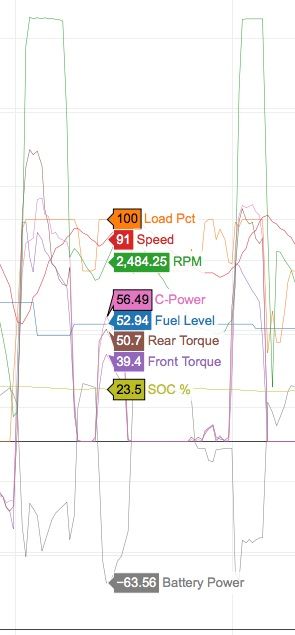Trex
Well-known member
Hi folks,
This will be the last test I will do for awhile. I hope it helps everyone.
I picked the flattest area around here ( and it is very flat across the river valley here) on the dual lane freeway (in each direction) that runs past our small city. It is made up of approx. 12kms of 100kph zone and 10km of 110kph zone. I picked that stretch for its easy turn around at each end as well as being flat.
So the test consisted of driving in one direction then the other followed by a quick turnaround at each end. Traffic was light. I sat on 105kph . I used cruise control the whole time except at each end when I was turning around.
Now this is the same as I did the other night but more scientifically ie I ran both directions fully before taking measurements to allow for any wind or elevation changes. I have not, I repeat not done that before.
Here are the results.
Press save button straight at start with full battery. 15 bars showing (out 16 ) on MMCS when finished test. 7.8L/100k Petrol motor never stopped. B5 15kw
Press Save at 13 bars. 14 bars showing (out 16 ) on MMCS when finished test. 7.8L/100k Petrol motor never stopped. B5 25kw
Press Save at 11 bars. 12 bars showing (out 16 ) on MMCS when finished test. 7.4L/100k Petrol motor stopped a couple of times B5 37kw
Press Save at 8 bars. 9 bars showing (out 16 ) on MMCS when finished test. 7.4L/100k Petrol motor stopped a couple of times. B5 37kw
Press Save at 7 bars. 8 bars showing (out 16 ) on MMCS when finished test. 7.4L/100k Petrol motor stopped a couple of times. B5 37kw
Press Save at 6 bars. 7 bars showing (out 16 ) on MMCS when finished test. 7.4L/100k Petrol motor stopped a couple of times. B5 37kw
Press Save at 4 bars. 5 bars showing (out 16 ) on MMCS when finished test. 7.2L/100k Petrol motor stopped like a proper hybrid. B5 37kw
At 1 bars (normal mode). 1 bars showing (out 16 ) on MMCS when finished test. 7.2L/100k Petrol motor stopped like a proper hybrid. B5 37kw
Note No AC or heater on.
Note The B5 amounts are Regen that I could get at the end of the runs with the paddles set to B5 when turning around.
Note Where I said the petrol motor never stopped it only stopped at each end of the run where I turned around.
Note Where the Petrol motor stopped I read it at the same point of the hybrid cycle.
Note I could not do this test more scientifically without putting it on a dyno.
Note I have just lost 6 hrs out of my life.
Note There are no more Notes. :lol:
Regards Trex.
This will be the last test I will do for awhile. I hope it helps everyone.
I picked the flattest area around here ( and it is very flat across the river valley here) on the dual lane freeway (in each direction) that runs past our small city. It is made up of approx. 12kms of 100kph zone and 10km of 110kph zone. I picked that stretch for its easy turn around at each end as well as being flat.
So the test consisted of driving in one direction then the other followed by a quick turnaround at each end. Traffic was light. I sat on 105kph . I used cruise control the whole time except at each end when I was turning around.
Now this is the same as I did the other night but more scientifically ie I ran both directions fully before taking measurements to allow for any wind or elevation changes. I have not, I repeat not done that before.
Here are the results.
Press save button straight at start with full battery. 15 bars showing (out 16 ) on MMCS when finished test. 7.8L/100k Petrol motor never stopped. B5 15kw
Press Save at 13 bars. 14 bars showing (out 16 ) on MMCS when finished test. 7.8L/100k Petrol motor never stopped. B5 25kw
Press Save at 11 bars. 12 bars showing (out 16 ) on MMCS when finished test. 7.4L/100k Petrol motor stopped a couple of times B5 37kw
Press Save at 8 bars. 9 bars showing (out 16 ) on MMCS when finished test. 7.4L/100k Petrol motor stopped a couple of times. B5 37kw
Press Save at 7 bars. 8 bars showing (out 16 ) on MMCS when finished test. 7.4L/100k Petrol motor stopped a couple of times. B5 37kw
Press Save at 6 bars. 7 bars showing (out 16 ) on MMCS when finished test. 7.4L/100k Petrol motor stopped a couple of times. B5 37kw
Press Save at 4 bars. 5 bars showing (out 16 ) on MMCS when finished test. 7.2L/100k Petrol motor stopped like a proper hybrid. B5 37kw
At 1 bars (normal mode). 1 bars showing (out 16 ) on MMCS when finished test. 7.2L/100k Petrol motor stopped like a proper hybrid. B5 37kw
Note No AC or heater on.
Note The B5 amounts are Regen that I could get at the end of the runs with the paddles set to B5 when turning around.
Note Where I said the petrol motor never stopped it only stopped at each end of the run where I turned around.
Note Where the Petrol motor stopped I read it at the same point of the hybrid cycle.
Note I could not do this test more scientifically without putting it on a dyno.
Note I have just lost 6 hrs out of my life.
Note There are no more Notes. :lol:
Regards Trex.



































